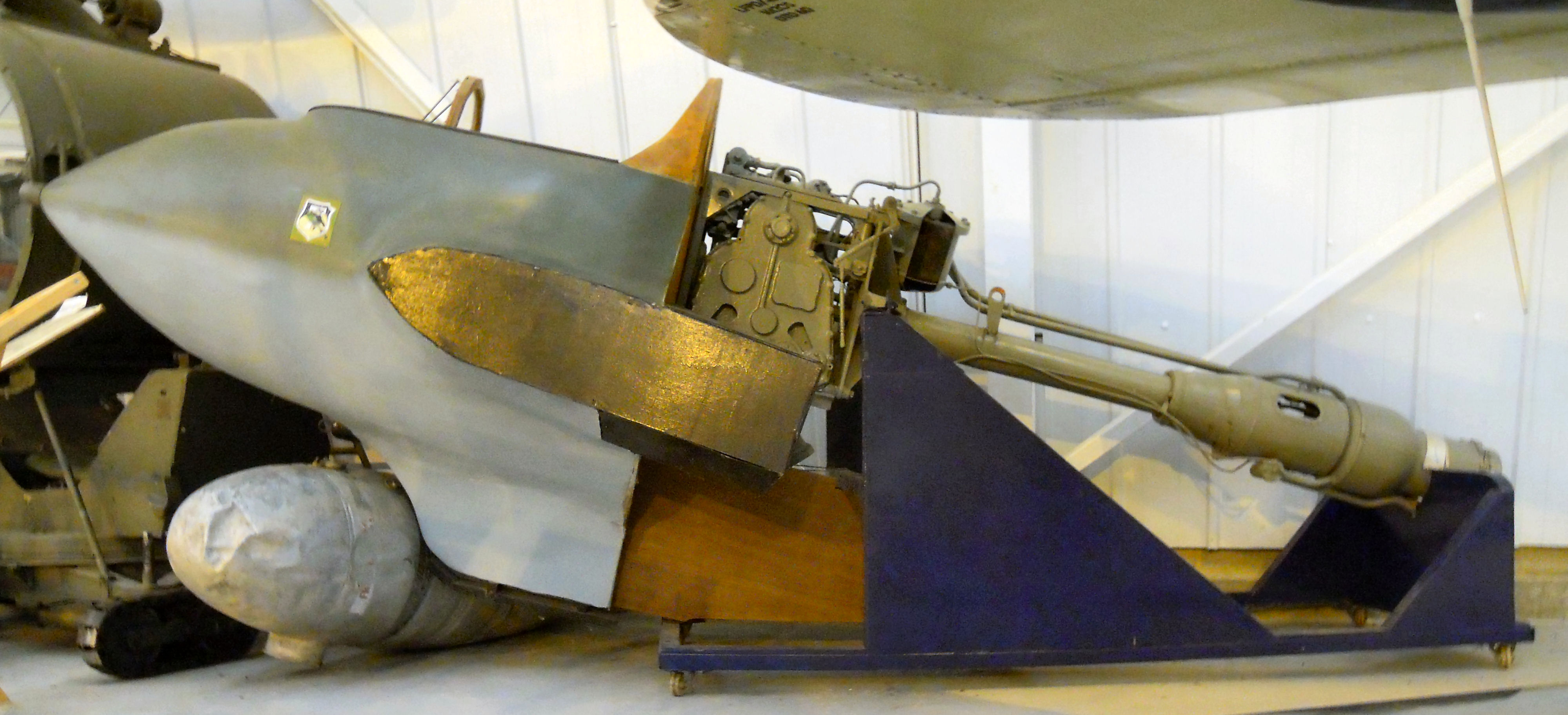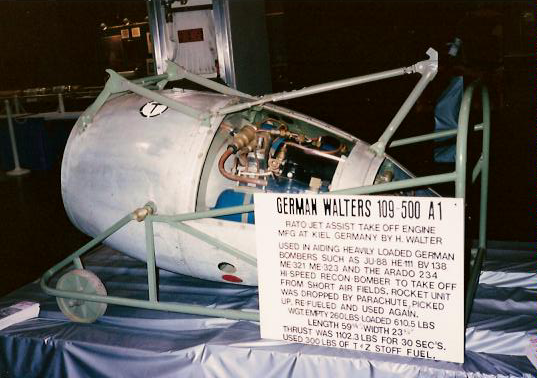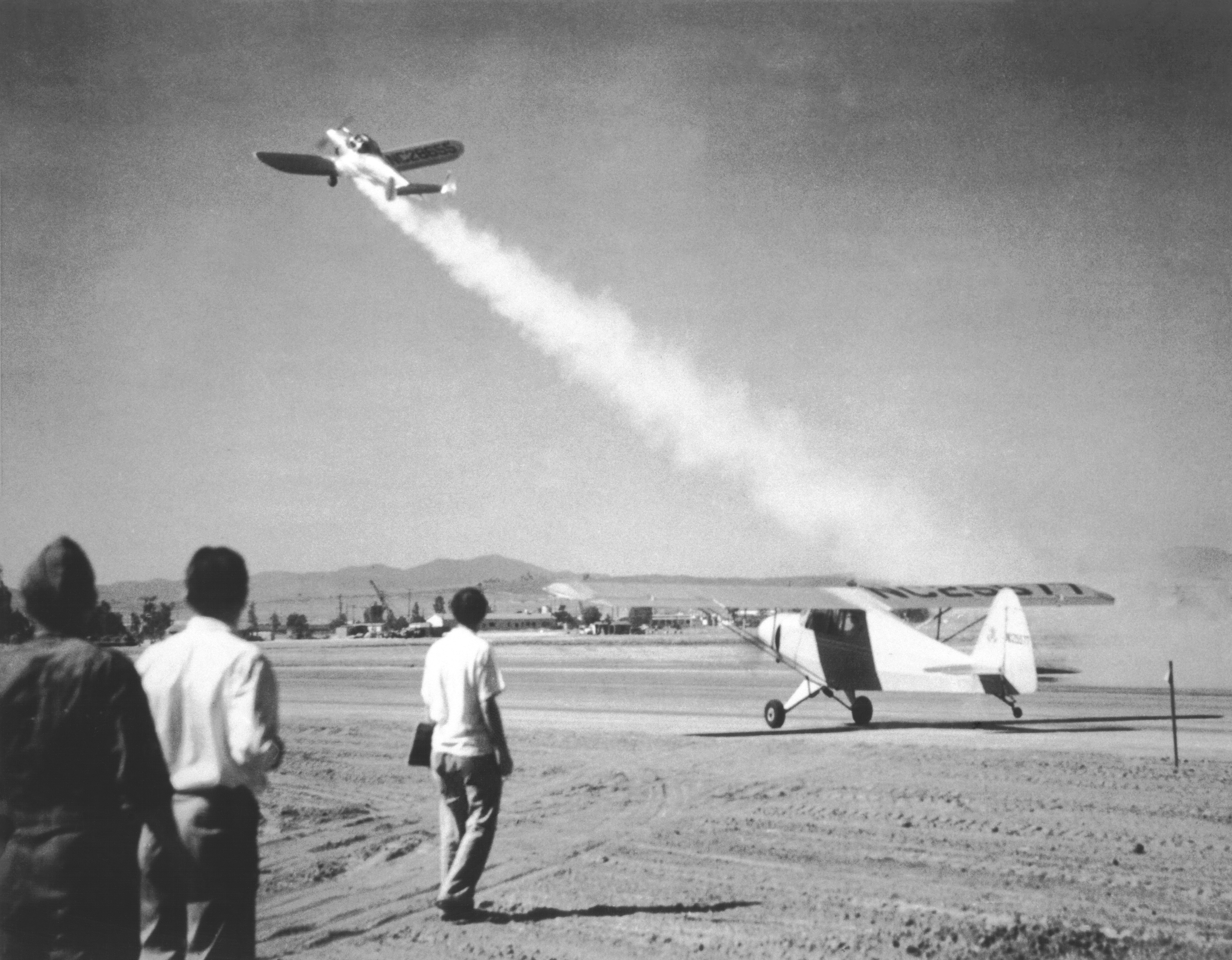|
T-Stoff
T-Stoff (; 'substance T') was a stabilised high test peroxide used in Germany during World War II. T-Stoff was specified to contain 80% (occasionally 85%) hydrogen peroxide (H2O2), remainder water, with traces (<0.1%) of stabilisers. Stabilisers used included 0.0025% , a mixture of phosphoric acid, and 8-oxyquinoline, and sodium stannate. Uses The decomposition of T-Stoff into hot steam and oxygen caused by the addition of the catalyst |
Messerschmitt Me 163
The Messerschmitt Me 163 Komet is a rocket-powered interceptor aircraft primarily designed and produced by the German aircraft manufacturer Messerschmitt. It is the only operational rocket-powered fighter aircraft in history as well as the first piloted aircraft of any type to exceed in level flight. Development of what would become the Me 163 can be traced back to 1937 and the work of the German aeronautical engineer Alexander Lippisch and the ''Deutsche Forschungsanstalt für Segelflug'' (DFS). Initially an experimental programme that drew upon traditional glider designs while integrating various new innovations such as the rocket engine, the development ran into organisational issues until Lippisch and his team were transferred to Messerschmitt in January 1939. Plans for a propeller-powered intermediary aircraft were quickly dropped in favour of proceeding directly to rocket propulsion. On 1 September 1941, the prototype performed its maiden flight, where upon quickly ... [...More Info...] [...Related Items...] OR: [Wikipedia] [Google] [Baidu] |
Walter HWK 109-509
The Walter HWK 109-509 was a German liquid-fuel bipropellant rocket engine that powered the Messerschmitt Me 163 Komet and Bachem Ba 349 aircraft. It was produced by Hellmuth Walter Kommanditgesellschaft (HWK) commencing in 1943, with licensed production by the Heinkel firm's facilities in Jenbach, Austria. Design and development Early versions of the Me 163 had been powered by an earlier design running on a "cold engine" fueled with Z-Stoff. This fuel tended to clog the jets in the combustion chamber, causing fluctuations in power and potentially explosions. Worse, however, was the fact that the engine could not be throttled, and when the aircraft leveled off after its climb to altitude it quickly accelerated to speeds that caused serious compressibility issues. The RLM demanded that a version be developed with a throttle. During this period Walter had also been working with a new fuel known as C-Stoff that gave off significant heat and was thus known as the "hot engine". ... [...More Info...] [...Related Items...] OR: [Wikipedia] [Google] [Baidu] |
C-Stoff
C-Stoff (; "substance C") was a reductant used in bipropellant rocket fuels (as a fuel itself) developed by Hellmuth Walter Kommanditgesellschaft in Germany during World War II. It was developed for use with T-Stoff (a high-test peroxide) as an oxidizer, which together with C-Stoff as the fuel, forms a hypergolic mixture. The proportions of the components in C-Stoff were developed to catalyse the decomposition of T-Stoff, promote combustion with the oxygen released by the decomposition, and sustain uniform combustion through sufficient quantity of the highly reactive hydrazine. The combination of the C-Stoff, used as a rocket fuel, with the T-Stoff used as the oxidizer, often resulted in spontaneous explosion from their combined nature as a hypergolic fuel combination, necessitating strict hygiene in fueling operations; there were numerous catastrophic explosions of the Messerschmitt Me 163 aircraft that employed this fuel system. Another hazard was toxicity to humans of each o ... [...More Info...] [...Related Items...] OR: [Wikipedia] [Google] [Baidu] |
Walter HWK 109-500
The Walter HWK 109-500 was a liquid-fuelled rocket engine developed by Walter in Germany during the Second World War. Description The 109-500 is a self-contained, modular monopropellant ''Starthilfe'' (take-off assist) engine in a pod, able to produce thrust for thirty seconds. After the fuel was expended, the pod was jettisoned and it returned to earth by parachute, with the parachute packed externally, onto the blunt forward end of the pod. The T-Stoff monopropellant, stored in the large spherical tank within the ''Starthilfe'' module's forward end, needed to react with a catalyst to provide the boosting thrust for an aircraft on takeoff - this Z-Stoff sodium or calcium-based, alkaline permanganate-compound (in an aqueous solution) catalyst was provided in a small tank above the reaction chamber just forward of the exhaust nozzle, with compressed air from a network of five pressure tanks driving the monopropellant and catalyst together through the reaction chamber, which ... [...More Info...] [...Related Items...] OR: [Wikipedia] [Google] [Baidu] |
Hypergolic
A hypergolic propellant is a rocket propellant combination used in a rocket engine, whose components spontaneously ignite when they come into contact with each other. The two propellant components usually consist of a fuel and an oxidizer. The main advantages of hypergolic propellants are that they can be stored as liquids at room temperature and that engines which are powered by them are easy to ignite reliably and repeatedly. Common hypergolic propellants are difficult to handle due to their extreme toxicity and/or corrosiveness. In contemporary usage, the terms "hypergol" and "hypergolic propellant" usually mean the most common such propellant combination: dinitrogen tetroxide plus hydrazine and/or its relatives monomethylhydrazine (MMH) and unsymmetrical dimethylhydrazine (UDMH). History In 1935, Hellmuth Walter discovered that hydrazine hydrate was hypergolic with high-test peroxide of 80-83%. He was probably the first to discover this phenomenon, and set to work devel ... [...More Info...] [...Related Items...] OR: [Wikipedia] [Google] [Baidu] |
JATO
JATO (acronym for jet-assisted take-off) is a type of assisted take-off for helping overloaded aircraft into the air by providing additional thrust in the form of small rockets. The term ''JATO'' is used interchangeably with the (more specific) term RATO, for ''rocket-assisted take-off'' (or, in Royal Air Force, RAF parlance, RATOG, for ''rocket-assisted take-off gear''). Early experiments and World War II In 1927 the Soviet research and development laboratory Gas Dynamics Laboratory developed solid-propellant rockets to assist aircraft take-off and in 1931 the world's first successful use of rockets to assist take-off of aircraft were carried out on a :ru:У-1, U-1, the Soviet Union military aircraft designation systems, Soviet designation for a Avro 504 trainer, which achieved about one hundred successful assisted takeoffs. Successful assisted takeoffs were also achieved on the Tupolev TB-1. and Tupolev TB-3 Heavy Bombers. The official test of the Tupolev TB-1 in 1933 shorten ... [...More Info...] [...Related Items...] OR: [Wikipedia] [Google] [Baidu] |
Z-Stoff
Z-Stoff (, "substance Z") was a name for calcium permanganate or sodium permanganate mixed in water. It was normally used as a catalyst for T-Stoff (high-test peroxide) in military rocket programs by Nazi Germany during World War II. Z-Stoff was used in the cold engine of the Messerschmitt Me 163, Messerschmitt Me 163 A airplane, in the earlier, self-contained HWK 109-500 ''Starthilfe'' RATO booster motor for manned aircraft (usually in pairs or multiples of two for such uses), and a smaller derivation of the ''Starthilfe'' unit, the Walter HWK 109-507, HWK 109-507 booster engine used with the Henschel Hs 293 anti-ship guided missile. T-Stoff decomposed by Z-Stoff was commonly used by World War II German military to generate steam for powering of fuel pumps in airplanes and rockets. The reaction produces manganese dioxide, which tends to clog the steam generators. Later generations of the Hellmuth Walter, Walter Rocket used solid-state catalyst instead of its water solution. [...More Info...] [...Related Items...] OR: [Wikipedia] [Google] [Baidu] |
V-1 Flying Bomb
The V-1 flying bomb (german: Vergeltungswaffe 1 "Vengeance Weapon 1") was an early cruise missile. Its official Ministry of Aviation (Nazi Germany), Reich Aviation Ministry () designation was Fi 103. It was also known to the Allies as the buzz bomb or doodlebug and in Germany as (cherry stone) or (maybug). The V-1 was the first of the (V-weapons) deployed for the terror bombing of London. It was developed at Peenemünde Army Research Center in 1939 by the at the beginning of the Second World War, and during initial development was known by the codename "Cherry Stone". Because of its limited range, the thousands of V-1 missiles launched into England were fired from V-1 flying bomb facilities, launch facilities along the French (Pas-de-Calais) and Dutch coasts. The Wehrmacht first launched the V-1s against London on 13 June 1944, one week after (and prompted by) the successful Operation Overlord, Allied landings in France. At peak, more than one hundred V-1s a day were fire ... [...More Info...] [...Related Items...] OR: [Wikipedia] [Google] [Baidu] |
V-2 Rocket
The V-2 (german: Vergeltungswaffe 2, lit=Retaliation Weapon 2), with the technical name ''Aggregat 4'' (A-4), was the world’s first long-range guided ballistic missile. The missile, powered by a liquid-propellant rocket engine, was developed during the Second World War in Nazi Germany as a "vengeance weapon" and assigned to attack Allied cities as retaliation for the Allied bombings of German cities. The rocket also became the first artificial object to travel into space by crossing the Kármán line (edge of space) with the vertical launch of MW 18014 on 20 June 1944. Research into military use of long-range rockets began when the graduate studies of Wernher von Braun attracted the attention of the Wehrmacht. A series of prototypes culminated in the A-4, which went to war as the . Beginning in September 1944, over 3,000 were launched by the Wehrmacht against Allied targets, first London and later Antwerp and Liège. According to a 2011 BBC documentary, the attacks from r ... [...More Info...] [...Related Items...] OR: [Wikipedia] [Google] [Baidu] |
Bipropellant
The highest specific impulse chemical rockets use liquid propellants (liquid-propellant rockets). They can consist of a single chemical (a monopropellant) or a mix of two chemicals, called bipropellants. Bipropellants can further be divided into two categories; hypergolic propellants, which ignite when the fuel and oxidizer make contact, and non-hypergolic propellants which require an ignition source. About 170 different propellants made of liquid fuel have been tested, excluding minor changes to a specific propellant such as propellant additives, corrosion inhibitors, or stabilizers. In the U.S. alone at least 25 different propellant combinations have been flown. As of 2020, no completely new propellant has been used since the mid-1970s. Many factors go into choosing a propellant for a liquid-propellant rocket engine. The primary factors include ease of operation, cost, hazards/environment and performance. History Development in early 20th century Konstantin Tsiolkovsky propo ... [...More Info...] [...Related Items...] OR: [Wikipedia] [Google] [Baidu] |
Hydrazine
Hydrazine is an inorganic compound with the chemical formula . It is a simple pnictogen hydride, and is a colourless flammable liquid with an ammonia-like odour. Hydrazine is highly toxic unless handled in solution as, for example, hydrazine hydrate (). Hydrazine is mainly used as a foaming agent in preparing polymer foams, but applications also include its uses as a precursor to polymerization catalysts, pharmaceuticals, and agrochemicals, as well as a long-term storable propellant for in-space spacecraft propulsion. Additionally, hydrazine is used in various rocket fuels and to prepare the gas precursors used in air bags. Hydrazine is used within both nuclear and conventional electrical power plant steam cycles as an oxygen scavenger to control concentrations of dissolved oxygen in an effort to reduce corrosion. the world hydrazine hydrate market amounted to $350 million. About two million tons of hydrazine hydrate were used in foam blowing agents in 2015. Hydrazines r ... [...More Info...] [...Related Items...] OR: [Wikipedia] [Google] [Baidu] |
Messerschmitt Me 263
The Messerschmitt Me 263 ''Scholle'' (plaice)Christopher 2013, p. 142. was a rocket-powered fighter aircraft developed from the Me 163 ''Komet'' towards the end of World War II. Three prototypes were built but never flown under their own power as the rapidly deteriorating military situation in Germany prevented the completion of the test program. History Although the Me 163 had very short endurance, it had originally been even shorter. In the first design, the rocket had no throttle and burned through its fuel in a few minutes. Not only did this sharply limit endurance, during flight testing pilots found the aircraft quickly exhibited compressibility effects as they levelled out from the climb and the speed picked up. This led the ''RLM'' to demand the addition of a throttle, leading to lengthy delays but a dramatic increase in fuel economy when throttled. This problem was addressed in the larger Me 163C, which featured the same HWK 509B or -C dual chamber rocket engine alre ... [...More Info...] [...Related Items...] OR: [Wikipedia] [Google] [Baidu] |









